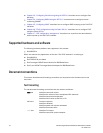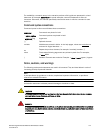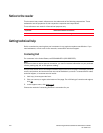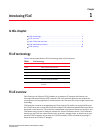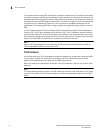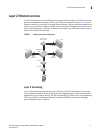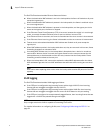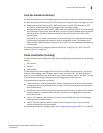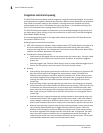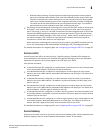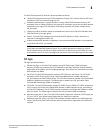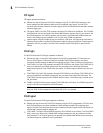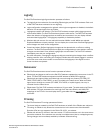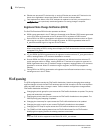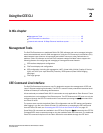6 Dell Converged Enhanced Ethernet Administrator’s Guide
53-1002116-01
Layer 2 Ethernet overview
1
Congestion control and queuing
The Dell FCoE hardware supports several congestion control and queuing strategies. As an output
queue approaches congestion, Random Early Detection (RED) is used to selectively and proactively
drop frames to maintain maximum link utilization. Incoming frames are classified into priority
queues based on the Layer 2 CoS setting of the incoming frame, or the possible rewriting of the
Layer 2 CoS field based on the settings of the CEE port or VLAN.
The Dell FCoE hardware supports a combination of two scheduling strategies to queue frames to
the egress ports; Priority queuing, which is also referred to as strict priority, and Deficit Weighted
Round Robin (DWRR) queuing.
The scheduling algorithms work on the eight traffic classes as specified in 802.1Qaz Enhanced
Transmission Selection (ETS).
Queuing features are described as follows:
• RED—RED increases link utilization. When multiple inbound TCP traffic streams are switched to
the same outbound port, and some traffic streams send small frames while other traffic
streams send large frames, link utilization will not be able to reach 100 percent. When RED is
enabled, link utilization approaches 100 percent.
• Classification—Setting user priority.
- Inbound frames are tagged with the user priority set for the inbound port. The tag is visible
when examining the frames on the outbound port. By default, all frames are tagged to
priority zero.
- Externally tagged Layer 2 frames—When the port is set to accept externally tagged Layer 2
frames, the user priority is set to the Layer 2 CoS of the inbound frames.
• Queuing
- Input queuing—Input queuing optimizes the traffic flow in the following way. Suppose a CEE
port has inbound traffic that is tagged with several priority values, and traffic from
different priority settings is switched to different outbound ports. Some outbound ports
are already congested with background traffic while others are uncongested. With input
queuing, the traffic rate of the traffic streams switched to uncongested ports should
remain high.
- Output queuing—Output queuing optimizes the traffic flow in the following way. Suppose
that several ports carry inbound traffic with different priority settings. Traffic from all ports
is switched to the same outbound port. If the inbound ports have different traffic rates,
some outbound priority groups will be congested while others can remain uncongested.
With output queuing, the traffic rate of the traffic streams that are uncongested should
remain high.
- Multicast rate limit—A typical multicast rate limiting example is where several ports carry
multicast inbound traffic that is tagged with several priority values. Traffic with different
priority settings is switched to different outbound ports. The multicast rate limit is set so
that the total multicast traffic rate on output ports is less than the specified set rate limit.
- Multicast input queuing—A typical multicast input queuing example is where several ports
carry multicast inbound traffic that is tagged with several priority values. Traffic with
different priority settings is switched to different outbound ports. Some outbound ports
are already congested with background traffic while others are uncongested. The traffic
rate of the traffic streams switched to the uncongested ports should remain high. All
outbound ports should carry some multicast frames from all inbound ports. This enables
multicast traffic distribution relative to the set threshold values.



